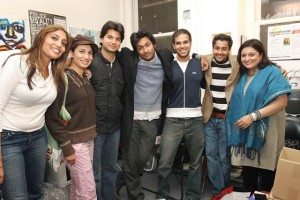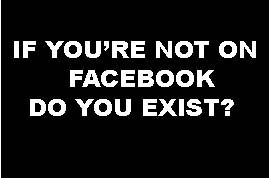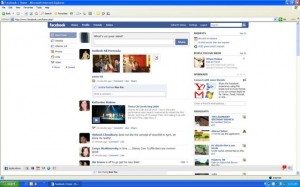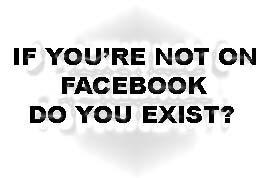I have to confess – I am a convert. No, not to Hinduism, Buddhism or Communism but to that newest quasi-religion sweeping the Universe – Social Networking! It’s the hot new belief system where you can sit meditating at a computer screen or Blackberry all day and yet connect with hundreds of your friends, network with thousands of business bigwigs and even launch a successful start-up!
Facebook, Linkedin, Twitter – these are words which did not even exist ten years ago! Now you have Facebook, Linkedin and Twitter evangelists and gurus, followers and the followed and hours spent communicating with fellow devotees. As a larger and larger part of the population gets sucked into a cyber world where you can instantly connect with people worldwide, the whole dynamics of communication are getting transformed.
Best of all, all this super activity doesn’t cost you a cent.
Be it the sharing of hot chai in a dhaba, or dancing at a 10 day wedding feast, Indians, by nature and genetics, love to connect, gupshup, and get involved with people intimately. Little surprise then that Indians and Indian-Americans are all over cyberspace and are active citizens of several social network worlds.
As these social networks spread across the world, they are doubling as wonderful professional resources too and there are a number of sites, notably LinkedIn, which helps in everything from networking to finding a mentor to landing a job in these hard economic times. Geographical boundaries are absolutely no obstruction for these global networks.
TWITTER, TWITTER, LITTLE STAR
While Facebook and LinkedIn have become popular in India, I was wondering where Twitter, a very much newer phenomenon, stood with Indians. Twitter asks one question, ‘What are you doing?’ and answers have to be under 140 characters and can be sent via mobile texting, instant message, or the web.
I shot out an email to the folks at Twitter Inc., and was amazed to get an almost immediate response from none less than Biz Stone, the co-founder of Twitter Inc. Talk about Tweets!
“We are beginning to think about internationalization and localization but so far we have only translated our web site into Japanese,” he wrote. “There are other ways that we are reaching out around the world, including a special SMS short code provisioned for India: 5566511. One of the most inspiring ideas about Twitter is the idea that we can extend the power of this real-time network to the weakest of signals around the world through the simple and ubiquitous technology of SMS.”
Knowing the power of SMS in India, people will surely soon be Tweeting away. While social networking sites do not provide ethnic breakdowns of the membership, the general figures of the major sites are impressive: According to statistics, Facebook has 150 million members, MySpace has 110 million; LinkedIn 50 million. Nor is all the networking just related to social relationships; executives from all Fortune 500 companies, for example, are LinkedIn members.
JOINING FACEBOOK, LINKEDIN AND TWITTER
And it’s a continually growing, continually evolving market: The New York Times noted that Facebook, which has 175 million members worldwide, has a huge potential audience in older people. “Many over-30 graybeards have yet to sign up, so Facebook has a chance for astonishing growth. Each week, a million new members are added in the United States and five million globally; the 30-and-older group is its fastest-growing demographic.”
Nor are these social network sites just for keeping up with old school friends or sharing photos with college pals, or finding new business support. They are a powerful way of having a worldwide impact – as candidate Barack Obama showed when he harnessed social networks to get a real movement for change going.
In fact, Obama had more than 3 million Facebook Friends who further used the tools on Facebook to spread the message. More than 900,000 people joined the “One Million Strong for Obama” group on Facebook, and there are scores of Facebook groups for Obama, and many young South Asians are a part of these.

As more and more desis take to the social networking sites, every South Asian cause, movie star, rock group and issue seems to be on Facebook! King Khan has over 500 fan groups. Facebook has over 250 Amitabh Bachchan Fan Clubs and appreciation groups – but there’s also a We Hate Amitabh Bachchan Group! Among the 135 fan groups for Preity Zinta, there’s even one called ‘The Only Reason I watched the Kings XI Punjab was Because of Preity Zinta!’ While some of these groups have just 11 members, others have over 50,000.
Now that everyone from college kids to movie stars to uncles and aunts and moms and dads are tweeting and social networking, I decided to find out what all the fuss is about. I took the plunge by joining both LinkedIn and Facebook, and in a way, it was like Alice falling through the rabbit hole into a strange, multicolored, wacky new world.
It’s like being a complete kid again – go to any friend’s home and scribble on their walls! Yes, the facebook walls which come with every home page are a place to shout out to friends, say what’s on your mind and get them to come to your home and write on your wall! Facebook is also terribly indulgent – it asks you what’s on your mind like a concerned parent or psychoanalyst, by the second! All great fun – and as one friend confided to me, you don’t feel the world is such a scary place anymore.
It was kind of strange to be encountering people I’d lost touch with or had chatted with years ago, strange to be sharing their snapshots, pages and music and learning minute to minute what was on their minds! It was fun to find out what friends were up to, what causes were moving them. Indeed on Facebook, nobody is shy – there are photo albums galore, videos Freudian quizzes they have taken, not to mention a daily analysis of what they’ve eaten and how they are feeling!
Sundip Arora, a sales engineer in Boston, says, “In this age, Facebook, My Space, Friendster, Orkut and others have become as much a part of our lives as calling friends once in a while to check up on them.” He adds that there’s definitely a major reduction in his cell phone bill as all the interaction with friends seems to be through the social network sites.
Arora admits he’s a Facebook addict and spends a few hours on it daily to get his dose of Friend updates, pictures, status updates, relationship statuses and the many other ways that people share aspects of their lives through Facebook
“Facebook is the new business card, you meet someone new and instead of asking ‘Do you have a business card?’ I find myself asking, ‘Are you on FB?” says Pooja Dhawan, a New Jersey entrepreneur in contemporary women’s wear. “It’s been incredible – I connected with high school friends after more than a decade last summer! I find Facebook more addictive than Myspace. I use FB for personal networking and Myspace for my business networking.”

Sidharth Sahoo, a consultant in Atlanta, is a veteran of Orkut and MySpace but now uses only Facebook. He says, “MySpace is too public and poorly designed plus you have to deal with all the spam. Orkut was great for getting back in touch with old friends in India but in the last 2 years almost everyone there too has moved to Facebook. I also just signed up with Twitter to see what all the hype is about but am not so sure I am a fan.”
Asked if these outlets help his work life too, he says, “Indirectly they have. There are some benefits to maintaining relationships in both worlds, particularly in consulting, but there are associated risks. For the most part I try keeping my professional and social networks separate. I am a member of LinkedIn and Doostang and both seem to be taking-off especially in the current economy with a lot more people spending time on these sites.”
Of course, most young people started with MySpace and Facebook while they were still in school, and have grown up with these tools. Zankhana Desai, a high school student in Atlanta, has not one but three social networking accounts – Facebook, MySpace and Orkut, and has also tried others such as Flixster and Zinch.
“I have had Facebook ever since I was a freshmen and it is pretty addicting. There is even a group on Facebook called ‘I Was Doing My Homework, Then I Ended Up on Facebook.’ No surprise that this group has 750,483 members!” She also utilizes Facebook for reasons other than socializing, since many businesses have made their own groups on Facebook which allow people to get discounts or apply for a job on Facebook.
The youth groups amongst Indian-Americans have realized the value of social networking and are utilizing it in a very savvy way to connect community members. NETIP (The Network of Indian Professionals) is one real time social networking group which has taken enthusiastically to these sites both as an organization and in the personal lives of its members.
Social networking sites are a valuable tool in promoting NETIP events and in educating the online community about the organization as a whole, and publicizing events via Facebook have been effective in generating widespread awareness. While formal membership and registration for NETIP events is required, there are new members joining NETIP related groups and events on Facebook everyday, which ultimately impacts membership.
Sriram Narasimhan, an account manager with GE in Phoenix, who is on the board of NETIP says, “Facebook has been vital to our marketing efforts, for creating awareness about the new Phoenix chapter, recruiting members, and publicizing events. We would not have been successful without Facebook. It is the first site people turn to when they want to meet others in the community.
There is certainly a cyber-togetherness built up which carries on to when one does meet in the flesh. A bond has been formed, the facebook bond, in a world of so many names and so many faces. Of course, no one will argue that quantity trumps quality. Some people have over 4000 friends! How deep can such friendships be? The idea seems to be to get connected with as many people as possible. Others keep it private, sticking with a handful of close friends. In fact, I came across some with just five or six friends – and they too get their fun with Facebook.
THE VILLAGE SQUARE
Indeed, it’s like living in a small village, meeting acquaintances daily in the square, and being included in events, even if they do happen to be often self- promotional ones! It’s all really quite nice and very inclusive. And sometimes you do learn of wonderful new artists or books or real causes.
For artists, deejays, authors and performers, social networking is a great way to keep in touch with their fan base and keep them informed of upcoming concerts and events. Pop star Tina Sugandh who is known as the Tabla Girl says, “Facebook allows me to tell everyone all at once what I’m up to. I love that, unlike a press release or a magazine article, you can deliver career info to fans in a very informal and personal way that makes you feel much closer to them!
“I get excited about things in my career and so I really love to share and hear their feedback. For example, I was so excited to be at Ringo Starr’s house playing tabla and singing on his album, and to be honest, one of the first things I did when I got home was to tell my Facebook friends since I knew they would share in my excitement.”
The fact that there is this very lucrative, captive audience available has not escaped corporations, big and small – and now nearly every business and product has a Facebook, LinkedIn or Twitter presence! Khabar magazine, for instance, has its fan following on Facebook, and even Kauai Hindu Monastery, creators of Hinduism Today, devoted to higher things, has realized the value of this very materialistic venue!
An email from the monks who run this popular magazine on Hinduism stated with humor: “Everyone knows Facebook, right? Kauai’s Hindu Monastery has been receiving suggestions from devotees to create a Facebook Page for months. A recent visitor to the monastery told us, ‘The time when people asked themselves the question ‘Should I be on Facebook?’ has passed.’ We realized that, just as we have a daily blog as well as a presence on iTunes and YouTube, Facebook would be yet another way to be a part of the lives of the 100+ million and growing Facebook population, which is expected to reach a billion in the near future.”
Indeed, the hard reality is that the arena of communications is changing dramatically and a web 2.0 presence has become mandatory. Businesses are fast realizing the need to utilize all aspects of social networking.
WORK AND PLAY

One young Indian-American who has become quite savvy at this, and jokingly refers to herself as a social networking goddess, is Anjula Acharia-Bath, CEO and founder of Desi Hits, a company founded on the back of social networking. Desi Hits got the Top 100 NYC OnMedia and OnHollywood Award for 2007-8, and was also the winner of the UK AMA’s ‘Best Website’ in 2008.
“Hooray for social networks!” she says. “I am a classic social network junkie that has used social networks throughout my professional life to drive whatever I am working on. I was one of the early ones using LinkedIn; I was a partner at the search firm called Forsyth Group and Linkedin was my network to thousands of candidates and clients.”
She then founded the multi platform media company www.desihits.com and used LinkedIn to grow the business, raise the second round of capital, employ people, find partners and push out the content offering to South Asians worldwide, using all three – MySpace, Facebook and Youtube. Desi Hits! content is also on third party sites such as YouTube, Facebook, MySpace and Orkut, getting increased exposure.
She recalls that when Bollywood actress Shilpa Shetty was in the Big Brother house in the UK, Desihits ran a ‘Keep Shilpa in the House’ campaign through Youtube, which brought lots of traffic to their site. Using pop stars in social networking campaigns, Desi Hits has also publicized everything from the Pussycat Dolls Jai Ho track to 50 Cents, the Hip-Hop icon, embracing Desi culture.
Be it business or politics, social networking is vital. As CEO of V-Power Inc, and ezCampaigns.com, and as founder and chairman of Statedemocracy Foundation, Shukoor Ahmed of Washington DC specializes in providing solutions to advocacy groups, political parties, candidates and non-profits. He has utilized LinkedIn, Facebook, Plaxo, Flickr, Twitter and You Tube to connect with people across the US, building up an impressive list of connections which helps him in furthering his entrepreneurial and civic efforts.
SPREADING THE WORD
Social networking is vital for getting the word out about every rising star and every new venture, and is especially loved by writers, artists and musicians. Geeta Citygirl, actor and artistic director of SALAAM Theatre, the first South Asian American theatre and arts company in the US, has used social networking for personal and professional connections. She says, “I have noticed that casting directors, filmmakers, writers and fellow actors are ‘meeting’ via FB. In some ways, FB is the new ‘community corner shop’ – the place to hang out, meet your friends and maybe even connect with your friend’s friends. The pace of things in our lives has definitely accelerated.”

One of the disadvantages, she says, is that you can get lost in the FB traffic – especially if you try to connect with everyone you have ever been in contact with! She says, “It’s crazy! Sometimes email feels safer and in a strange way, more personal. But then I get a reality check from one of my younger cousins who can’t believe I still do email. She always laughs at how ‘ancient’ I am. There’s a real reality check, huh?”
Facebook is becoming integral to finding lost friendships and sometimes is the resting place, and port of call for last goodbyes and memorials. Citygirl recalls how she got re-connected to Diana Nichols, a dear high school friend, through Facebook. When Diana recently passed away from a severe asthma attack, her heartbroken friends put up a memorial for her on Facebook. She says, “Near or far, we mourned her passing together – cyberly via FB. We continue to stay connected to her son – Joshua and her fiancé Rusty via FB. And in a way, I know Diana is somewhere laughing and enjoying all this.”
Partha Banerjee, a writer, academic and activist in Brooklyn, New York, has used several social networking tools for a variety of purposes. He says, “Social networking is a new Internet phenomenon, and just like upper and middle class Americans with a flare for online ‘friendship’, Indians are also taking advantage of it.” His Facebook and LinkedIn networks have a large number of Indian friends. While he publicizes his writing agency The Scriptline, Inc. on LinkedIn, he has also been teaching a Labor and New Media class this semester at Empire State College where he is finding ways to popularize the various networks for the labor movement.
“Others working for humanitarian or political causes have invited me to be a part of their Facebook page,” he says. “The question is: what does it all have to do for people who don’t even have access to education, let alone computers with an Internet connection? Isn’t it making the world even more digitally divided?”
While this is true, social networking is providing an empty canvas and a large, compassionate audience for just about any social cause in the world. Be it illiteracy, corruption, the tragedy of Darfur or that of child laborers, there is a group banding together to protest it. The younger generation, especially, has idealism and a hunger to solve problems and social networking is providing a common backyard to reach like-minded people across the globe.
DOING GOOD, FINDING PARTNERS AND MORE
What is amazing is the number of groups that are fermenting all over LinkedIn and Facebook to suit every dream and desire. Just key in the word ‘Indian’ into a search on LinkedIn, and you come up with more than a hundred groups aimed at NRIs, PIO’s and OCI’s or anyone else with a bond to India. Want to return back to India and take up a job there? You have groups like Returning Indians, NRI and even ‘Proud to Say We are Indian’! This is networking across continents, finding jobs and friends in cross-country moves.
And of course, we being desis, let’s not forget what really moves us – finding partners for every single – willing or unwilling – that we know! Thus on Facebook you have all sorts of groups including ‘Help find My Friend a Bride’, ‘Serious Muslim Partner’, and even ‘Arranged Marriage Partner’, whose description says it all: “You too can be a matchmaking aunty jee and send your single friends their ideal (or not so ideal!) marriage partner!”
Social networking is certainly opening up new avenues and creating new ways for things to get done – such as creating content online – and on the go! Rajesh Setty is a cyber entrepreneur and author of the popular blog Life Beyond Code. You can also follow him on Twitter at @UpbeatNow
“Most often these tools captivate people rather than people capitalizing on them,” says Setty, who uses LinkedIn, Facebook and Twitter. “Popularity of a tool does not automatically mean that it’s right for you. Twitter is popular but if you can’t express cool ideas in less than 140 characters or you don’t have a strategy to capitalize on Twitter, it is not worth venturing into it.”
Ask him how he’s harnessing the three networks for his work, and he says, “I have connected my blog feed to Twitter and my Twitter stream to Facebook status updates. So there is an automatic way of getting the word out on some of the things that I am doing.”
Recently he used all three networks to create an E-book in less than four weeks! “Being in Silicon Valley, I see people getting laid off almost everyday,” he says. “Actually, I see more people who are in the ‘fear of a layoff’ everyday. Talking to them in the last couple of months, I think the ‘living in the fear of facing a layoff’ is worse than being laid off.”
So he decided to write an e-Book titled ‘Defiant: Facing a Layoff And Doing it Well Anyway.’ He says, “Rather than writing everything on my own, I decided to get help from other experts that are out there. I posted a request on LinkedIn, Facebook, Twitter and on my blog. In less than four weeks, I had more than fifty people submitting a tip to help people facing a layoff. The book is now complete and ready to be released in the next few weeks!” No writer’s block here!
Zankana Desai, student and citizen of tomorrow, with the exuberance of youth, prophesizes this about the future trends, “I think Facebook may be the major place for all news, stories, gossips, and pretty much everything that goes on, creating a sense of unity. I can see the rise of a universal website bringing the world together.”
It may not be Facebook – it may be some other networking tool not yet invented. But things are going to get only more exciting as access becomes more and more easy. For Indians who are spread across scattered parts of the Diaspora, social networking unites them in a wonderful way that even email cannot do – it creates a tenacious community, a floating homeland where they can indulge in all their common interests.
Often living far from desi networks, these Indian immigrants and their children can connect with their roots, their rhythms, their Bollywood, their huge extended families worldwide. Now they don’t have to send out a telegram or shout out over crackling phone lines. All they have to do is sign in to Facebook, LinkedIn or simply Tweet – and the emotional payback is as rich as getting to slurp on the juicy core of a fragrant Alphonso mango. As technology continues to scale new heights, the frenetic roller coaster ride to the future is only just beginning!
*****************
FOR INDIANS, ORKUT IS THE TOP OF THE HEAP
What do millions of Indians turn to for their social networking needs? A report by comScore Inc., shows that Orkut is the clear leader, with more than 19 million visitors in December 2008. Orkut’s audience was three times the size of its nearest competitor in the category. Facebook.com captured the #2 position with 4 million visitors, up 150 percent versus year ago, followed by local social networking site Bharatstudent.com with 3.3 million visitors (up 88 percent) and hi5.com with 2 million visitors (up 182 percent).
Top Social Networking Sites in India by Unique Visitors December 2008 vs. December 2007 Total India – Age 15+, Home/Work Locations* Source: comScore World Metrix |
|||
|
|
Total Unique Visitors (000) | ||
| Dec-07 | Dec-08 | % Change | |
| Total Internet : Total Audience | 26,240 | 32,099 | 22 |
| Social Networking | 12,795 | 19,369 | 51 |
| Orkut | 7,123 | 12,869 | 81 |
| Facebook.com | 1,619 | 4,044 | 150 |
| Bharatstudent.com | 1,736 | 3,269 | 88 |
| hi5.com | 714 | 2,012 | 182 |
| ibibo.Com | 1,970 | 990 | -50 |
| MySpace Sites | 352 | 741 | 110 |
| LinkedIn.com | 293 | 513 | 75 |
| PerfSpot.com | 2,106 | 433 | -79 |
| BIGADDA.com | 515 | 385 | -25 |
| Fropper.com | 256 | 248 | -3 |
*Excludes visits from public computers such as Internet cafes and access from mobile phones or PDAs.
Source: comScore
MEET ME IN FACEBOOK!
Individual voices of Indian-Americans who believe in social networking.
“I started with Friendster, passed on MySpace and have graduated with honors on Facebook. I am definitely addicted! I like that these social networking sites keep you connected to friends near and far, and despite the distance and time difference, you always have a good idea of what they may be up to.
Thanks to Facebook, I have been able to stay tuned to the wedding planning process of two of my closest friends from high school – both of whom I had been out of touch with for almost fifteen years until we “ran across” each other via Facebook this past year!”
– Aruna Paramasivam, Management Consultant in Philadelphia
“Facebook has become a sort of one-stop resource center for me where I can catch up with friends and stay current with events around town. Through features such as status updates, photo sharing, and message postings, I’m able to provide a snapshot of what’s going on in my life.”
– Anita Ramakrishna, advertising professional in New York
“I used to use Xanga and MySpace but now I’m addicted to Facebook. It’s a huge distraction from studying and other activities,” she says ruefully. “People tend to go on Facebook chat, post comments, reply to messages, and look through pictures. It is also a great way to keep in touch with people that are far away. I was in the pageant last summer and I still keep in touch with the girls through Facebook.”
– Divya Swamy, 16, a junior at Chattahoochee High School in Atlanta
Shruti Tiwari, CEO at MediaSphere, a New York based event management agency has also found social networking to be a cost effective way of getting results. Using both LinkedIn and Facebook, she says, “I have effectively used LinkedIn and Facebook to help my multinational clients serving the Indian-American community to meet their goals by reaching a wider belt of ethnic audiences. I have also strategized viral media campaigns, corporate blogs and websites, depending on the brand’s needs.”
-Shruti Tiwari, CEO, MediaSphere, a New York event management agency.
(c) Lavina Melwani
This article first appeared in Khabar magazine




4 Comments
Jai Ho, indeed! How do you find it’s changed your life – is it in keeping up with family you left behind or in making new friends? And do you sometimes find it taking over your life?
What a comprehensive comment on how important the digital social networking world has turned out to be! i agree with you, and in fact, i’ve found that my old life, the one i thought i’d had to abandon when i immigrated, has found its way back to me!
i love it, like the rest of the world, esp. the desi world!
Jai Ho, FB!!!
I recall the time when even email was new and people would self-consciously mention their web addresses, with a smile. Now it’s all part of our DNA! There’s no going back to the old way and it will be interesting to see where all this takes us.
Hi Lavina, Good article and a good indication of the use of social networks by everybody who wants to get their name/purpose out there. As the owner of a digital marketing company myself, I live and breathe this daily not just for clients but for myself. I love to tweet and am equally active on Facebook.
The best thing about these social networks is that it breaks the barriers that used to exist even as recently as two years ago. Reaching decision makers is so much easier using Twitter or Linkedin.
I feel that reaching individuals who can create “quality” content and not worry so much about the “quantity” of contacts are the ones who will get the biggest return on their time spent online.
Regards
Nipa Shah
http://www.jenesysgroup.com